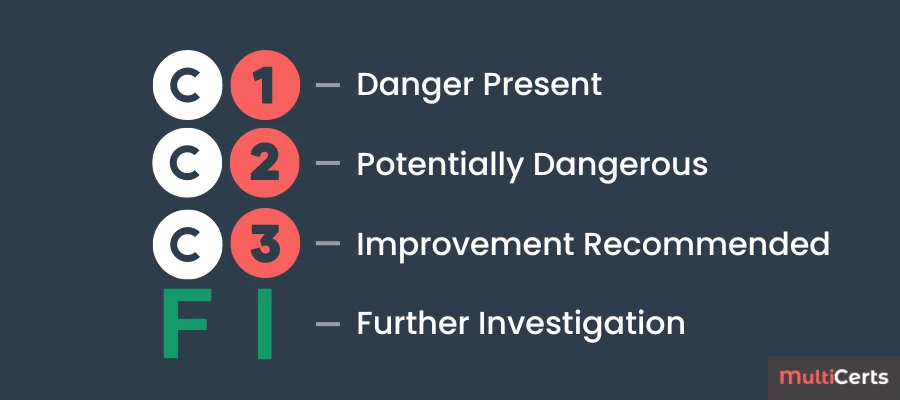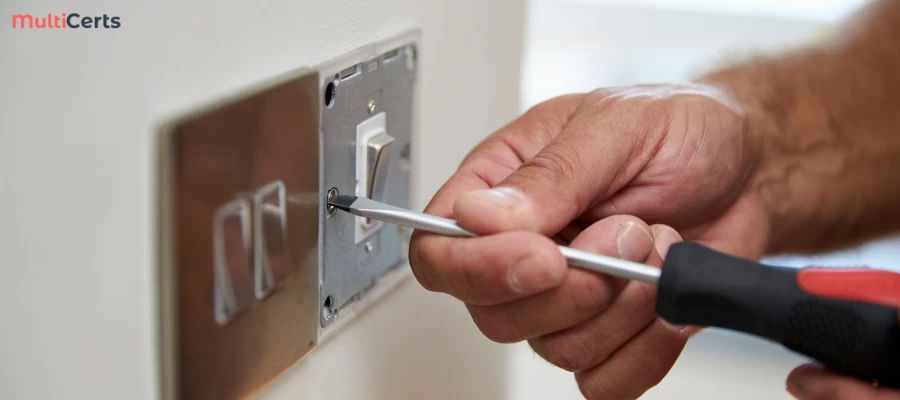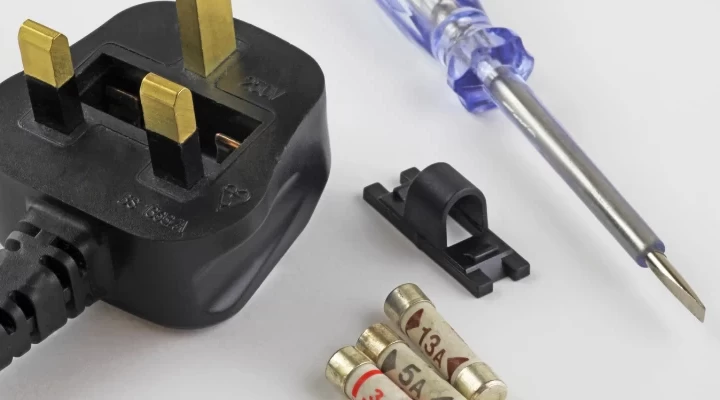Table of Contents
As professional electricians, we encounter various types of electrical installations, each with its own complexities and potential issues. During an EICR, we thoroughly inspect the electrical installation, looking for any non-compliances with the current safety regulations. The findings are then categorized using specific EICR codes, which indicate each issue's danger level, severity and recommended actions.
We use three principal EICR codes: C1 (danger present, requiring immediate action), C2 (potentially dangerous, requiring urgent action), and C3 (improvement recommended). By understanding and applying these codes, we ensure that the people who live or work in these spaces are protected from electrical hazards and that the installations meet the required safety standards. In the following sections, we will delve deeper into the EICR codes and provide insights into their applications in real-life scenarios.
Understanding EICR Codes
C1: Danger Present
When we conduct an EICR, we use codes to classify the condition of the electrical installations. A C1 code indicates that there is immediate danger present. It means that we have found serious issues that immediately threaten people or property. Examples of such issues may include exposed live parts or incorrect wiring that could cause fires or electric shocks. In these cases, we take immediate action to rectify the problem or issue a warning to refrain from using the affected installation.
C2: Potentially Dangerous
The C2 code is used when we identify installations where potential dangers exist. While these may not pose immediate threats like C1 situations, they still require attention to prevent future hazards. Some common examples are:
-
Insufficient earthing
-
Overloaded circuits
-
Absence of RCD protection on sockets
It is crucial to address C2 issues in a timely manner to ensure the safety and reliability of the electrical installations in our properties.
C3: Improvement Recommended
The C3 code is given when we find minor non-compliances with current electrical standards. Though these observations do not pose an immediate or potential danger, they should be considered for improvement. Examples of C3 issues can include:
-
Outdated or damaged switchgear
-
Lack of proper labelling on circuits
-
Insufficient socket outlets
By addressing C3 recommendations, we can enhance our electrical installations' overall efficiency and safety.
In conclusion, understanding the EICR codes is essential for determining the condition and safety of our electrical installations. Regularly obtaining EICR assessments and taking appropriate actions based on the assigned codes can minimize the risk of electrical hazards and maintain a safe environment.

EICR Inspection and Report Process
Initial Inspection
During the initial inspection, the electrical installation condition report (EICR) is primarily concerned with identifying any issues with the installation that could lead to dangerous conditions. Some common issues our inspectors look for include:
-
Age and wear of electrical systems
-
Overloaded circuits
-
Damage to equipment or wiring
-
Inappropriate use of electrical components
-
Missing or inadequate protective devices
After thoroughly examining the electrical installation, we document any observations and assign an appropriate classification based on the EICR Classification System.
EICR Classification System
The EICR Classification System determines the severity of any issues found during the inspection. We use the following classifications:
ClassificationDescriptionC1Danger present, immediate remedial action requiredC2Potentially dangerous, urgent remedial action requiredC3Improvement recommendedFIFurther investigation required
-
C1 and C2 classifications denote issues that pose serious safety risks and require prompt action.
-
C3 issues are non-urgent, but we recommend addressing them to improve the overall safety of the electrical system.
-
If we identify a situation that requires deeper investigation, the "FI" classification is assigned. This indicates that more detailed assessments are necessary before determining the appropriate remedial actions.
After completing the EICR inspection, we compile our findings into a comprehensive report. The report includes details of all observations, their respective classifications, and any recommended actions. This enables clients to prioritize and plan necessary maintenance tasks to ensure the ongoing safety of their electrical installations.
Addressing EICR Observations
Urgent Remedial Action
When we encounter an EICR report that indicates an unsatisfactory condition, urgent remedial action is often required. This action is necessary to rectify any potentially dangerous scenarios in the electrical installations. In these cases, we prioritize safety and work efficiently to correct the problems. Examples of urgent remedial actions include:
-
Repairing or replacing damaged electrical components
-
Ensuring proper earthing and bonding of installations
-
Upgrading the electrical system to meet current safety standards
Further Investigation
Sometimes, an EICR report might suggest that certain aspects require further investigation. In these situations, we conduct detailed examinations of the identified areas to gain a better understanding of the issue. Our analysis helps us determine the best course of action to rectify the issue and ensure the safety of the electrical installation. The steps taken in further investigation may include:
-
Inspecting concealed wiring
-
Testing individual circuits for potential faults
-
Evaluating the performance of safety devices
Repairs
Once we've identified the issues in the EICR report, we focus on repairing or replacing the necessary components. Our goal is to achieve a satisfactory EICR report and ensure that the electrical installations meet safety standards. We carefully carry out the required alterations, including:
-
Repairing or replacing faulty circuit breakers
-
Tightening loose connections and replacing worn-out wiring
-
Upgrading outdated equipment to meet current regulations
By diligently addressing EICR observations, we strive to maintain the safety and reliability of electrical installations. Our proactive approach helps prevent potential hazards and ensures compliance with relevant regulations.

Managing Electrical Installations
Regular Testing and Maintenance
Regular testing and maintenance of electrical installations are crucial to ensuring their safety, reliability, and efficiency. We recommend conducting inspections at least once every five years for commercial properties and at least once every ten years for residential properties.
Some key aspects of testing and maintenance include:
-
Visual inspection: Check for signs of wear, damage, or overheating in wiring and electrical components.
-
Electrical testing: Measure parameters such as insulation resistance, earth fault loop impedance, and functionality of protective devices.
-
Documentation: Keep records of all testing and maintenance activities, including any necessary repairs or improvements.
Ensuring a Safe and Satisfactory Condition
Ensuring the safe and satisfactory condition of electrical installations involves several steps:
-
Design and installation: Make sure electrical installations are designed and installed in accordance with relevant standards and regulations.
-
Regular testing and maintenance: As mentioned above, perform testing and maintenance activities at regular intervals to detect and address any issues.
-
Compliance with EICR codes: Obtain an Electrical Installation Condition Report (EICR) after every inspection, and ensure that the installation complies with the EICR codes:
-
EICR CodeMeaningC1Danger present, immediate remedial action neededC2Potentially dangerous, urgent remedial action requiredC3Improvement recommended but not immediately dangerous
-
Promptly address any issues: Take necessary steps to rectify any identified issues, especially if they are classified as C1 or C2. It's essential to prioritize the safety of the occupants and ensure the electrical installations are in satisfactory condition.
By adhering to these practices, we can ensure that our electrical installations are safe, reliable, and efficient, contributing to a better environment for all.
EICR Documentation and Reporting
EICR Document Contents
As part of the EICR process, we provide clear and concise documentation detailing the condition of the electrical installations in question. Within the EICR document, we include the following information:
-
Details of the client, site, and installation
-
Inspection and testing results
-
Listing of any defects or non-compliances
-
Recommendations for necessary remedial actions
-
Attachments such as circuit charts or photographs, if relevant
It is essential that we ensure our EICR document is easily understandable and can be used to take appropriate actions to maintain the safety and compliance of the electrical installations.






